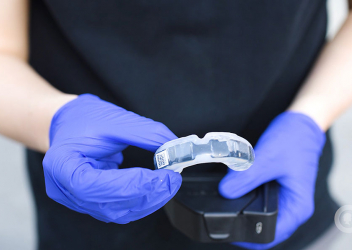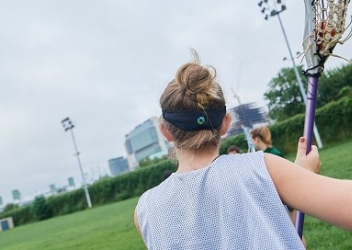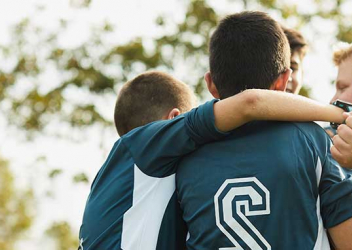Biomechanics and Concussion Prevention
The use of biomedical engineering and biomechanics enables the Minds Matter Concussion Program team to study how the human body reacts to forces that can cause concussions. For instance, the team is measuring repetitive head impacts to understand how biomechanical loads and impact exposures lead to injuries and deficits in human physiological function. We have a mix of on-the-field and lab-based research studies that use head impact sensors and finite element modeling. Our research has led us to also focus on evaluating the accuracy of the head impact sensors used in sports and validating head sensor research methods. One goal is an improved head impact sensor design and their continued use high-quality high-impact research.
Research Projects
- Consensus Head Acceleration Measurement Practices (CHAMP)More
CHAMP is a scientific working group that convened in 2022 to establish consensus on best practices for the collection, analysis, and reporting of head acceleration measurement data in sport. Recommendations were published as a series of technical manuscripts submitted to- and published in Annals of Biomedical Engineering. A series of checklists accompany the manuscripts outlining recommended reporting for studies using these methods. Kristy Arbogast, PhD, CIRP and Minds Matter Co-Director, served on the leadership team for CHAMP and was lead author on the flagship paper describing the process and outcomes.
- Measuring Repetitive Head Impacts Via SensorsMore
Minds Matter researchers are deploying head impact sensors to quantify biomechanical load exposure by sport and sex, and relationships between load exposure and neuro-functional metrics. Integrated with other research aims and methods, research using head impact sensors will provide new knowledge regarding high-risk biomechanical settings for the young brain.
- NFL Engineering Roadmap
Through its Co-Director Kristy Arbogast, PhD, the Minds Matter Concussion Program team plays a leadership role in the NFL’s Engineering Roadmap, helping to set and oversee the implementation of this initiative’s research plan. In 2016, the League pledged $60 million over the next five years to improve the understanding of injury prevention in professional football and to create incentives for small businesses, entrepreneurs, innovators and helmet manufacturers to develop new protective equipment.
The primary purpose of the Engineering Roadmap is to stimulate innovation in a very open and transparent way to improve the safety of the game. This body of work will provided needed understanding, at a very detailed mechanical level, of the scenarios in which injuries are happening and provide the data to direct the development of evidence-based innovations.
Laboratory Evaluation of Shell Add-On Products for American Football Helmets for Professional Linemen
Comparison of Laboratory and On-Field Performance of American Football Helmets
This paper describes the relationship between laboratory tests and on-field performance of football helmets worn by players in the NFL. A helmet performance score (HPS) was determined from laboratory tests and helmet model usage, player participation, and incident concussion data across five NFL seasons were used to calculate on-field helmet model-specific concussion rates. Comparison of laboratory HPS to the helmet model-specific concussion rates showed a positive correlation, indicating that helmets which performed well in the lab were also generally associated with lower concussion rates on-field, thus supporting the decision to prohibit on-field use of helmets with poor HPS.
Position-Specific Circumstances of Concussions in the NFL: Toward the Development of Position-Specific Helmets
This analysis quantified position-specific features of scenarios resulting in concussions sustained by NFL players. While some aspects of concussion scenarios are common to all positions, several position-specific differences exist that can inform the design of position-specific helmets. For example, helmet to ground impacts to the back of the helmet are over-represented for quarterbacks. Additional position-specific details are outlined in the paper.
Development and Evaluation of a Test Method for Assessing the Performance of American Football Helmets
A combination of video review, videogrammetry, and laboratory reconstructions was used to characterize concussive impacts from NFL games during the 2015-2017 seasons. This information was then used to define test conditions (e.g. impact locations and speeds) for laboratory helmet testing and a method for scoring overall helmet performance was created. Results from tests of 36 helmets at two laboratories are outlined in this paper to evaluate the reproducibility of this new protocol.
On-Field Performance of an Instrumented Mouthguard for Detecting Head Impacts in American Football
This study describes the development and evaluation of an instrumented mouthguard and associated machine learning model for collecting head impact data from football athletes on-field and distinguishing true head impacts from spurious events. Data are shared from college football athletes over two seasons illustrating the overall performance of the system.
Surface Contact Features, Impact Obliquity, and Preimpact Rotational Motion in Concussive Helmet-to-Ground Impacts: Assessment via a New Impact Test Device
This paper describes the development of a test device for replicating unique features of concussion-causing helmet to ground impacts.
Laboratory Reconstructions of Concussive Helmet-to-Helmet Impacts in the National Football League
Seventeen concussive helmet-to-helmet impacts occurring in NFL games were analyzed using video footage and reconstructed by launching helmeted crash test dummies into each other in a laboratory. Repeatability, accuracy of input conditions, and accuracy of reconstruction output was assessed.
The Biomechanics of Concussive Helmet-to-Ground Impacts in the National Football League
This 2019 study provides a detailed characterization of the biomechanics of helmet-to-ground impacts leading to concussions in the National Football League including video analysis of on-field injuries and recreation of impact conditions using a helmeted anthropomorphic test device.
Video Analysis of Reported Concussion Events in the National Football League During the 2015-2016 and 2016-2017 Seasons
In this 2018 study, detailed video of concussions sustained in the NFL during the 2015-2016 and 2016-2017 seasons were reviewed to gain insight on injury causation, the outcome of rule changes and guidance on future injury prevention strategies. This review highlighted the importance of helmet to ground and helmet to body of the opposing player as causation scenarios in addition to the commonly studied helmet-to-helmet.









